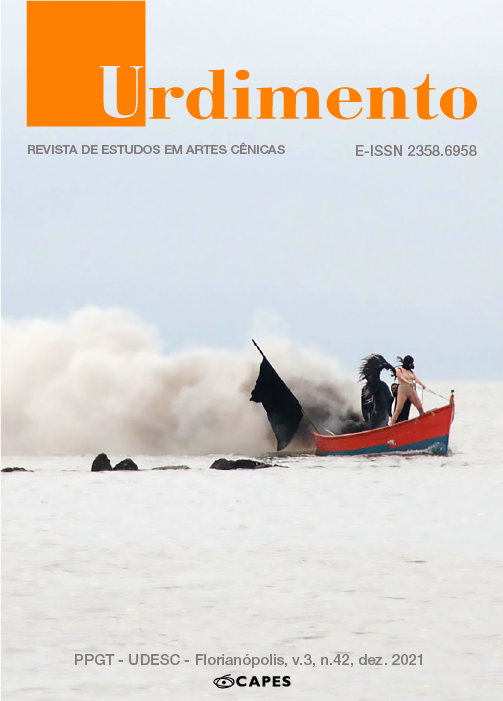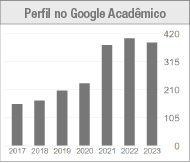Viewpoints e cognição: Soft focus e integração multissensorial
DOI:
https://doi.org/10.5965/1414573103422021e0101Palavras-chave:
Psicologia Cognitiva, Sinestesia, Dança , ViewpointsResumo
O treinamento Viewpoints tem sido usado nas últimas décadas como uma ferramenta para improvisação e composição em dança e teatro. Teoriza-se que desenvolve os sentidos para respostas rápidas, destaca a atenção, melhora a sensação de vivacidade no palco, desenvolve a consciência e a dinâmica de grupo. Nesta pesquisa, conceitos da psicologia cognitiva foram usados para compreender os processos que podem ocorrer durante o treinamento. Sugere-se que um tipo de "sinestesia" pode ocorrer e aumentar a interação entre os sentidos. Um quasi experimento foi aplicado para investigar os processos perceptuais e cognitivos envolvidos. Resultados revelam um impacto positivo na sincronia e coesão do grupo.
Downloads
Referências
AFRA, Pegah; FUNKE, Michael; MATSUO, Fumisuke. Acquired auditory-visual synesthesia: A window to early cross-modal sensory interactions. Psychology Research and Behavior Management 2: p.31–37, 2009.
APA - American Psychological Association - Dictionary of Psychology. Disponível em: https://dictionary.apa.org/quasi-experimental-research Acesso em: Nov. 2021.
BASSO, Julia C.; SATYAL Medha K.; RUGH Rachel. Dance on the Brain: Enhancing Intra- and Inter-Brain Synchrony. Frontiers in Human Neuroscience, 14, Article 584312. https://doi.org/10.3389/fnhum.2020.584312, 2021.
BOGART, Anne. A Director Prepares: Seven Essays on Art and Theatre. Routledge, NY. 2003.
BOGART, Anne. What’s the Story: Essays about art, theater, and storytelling. Routledge, NY. 2014.
BOGART, Anne, LANDAU, Tina. The Viewpoints Book: A practical guide to Viewpoints and composition. Theatre Communications Group, NY. 2005.
CALVO-MERINO, Beatriz; GRÈZES, Julie; GLASSER, D.; PASSINGHAM, Richard E.; HAGGARD, Patrick. Action observation and acquired motor skills: an fMRI study with expert dancers. Cerebral Cortex. 15, p.1243-1249. 2005.
CLIMENHAGA, Royd. Anne Bogart and Siti Company: Creating the moment. Ed. Alison Hodge Actor Training, 2nd Edition. Taylor & Francis e-library, Routledge: p.288-304, 2010.
CHRISTENSEN, Larry B. Experimental methodology.10th Edition, Pearson International Edition, Allyn & Bacon, United States of America. 2007.
DYER, John R.G., JOHANSSON, Anders, HELBRING, Dirk, COUZIN, Iain D., KRAUSE, Jens. Leadership, consensus decision making and collective behavior in humans. Philosophical Transactions of The Royal Society 364: p.781-789, 2009.
ERNST, Marc O. Multisensory Integration: A Late Bloomer. Current Biology Vol 18 No 12, p.519-521. 2008.
GARDNER, Howard. Frames of mind: A theory of multiple intelligences. New York, Basic Books, 1983.
GARDNER, Tony. Signs of the Times: Structures and signatures. Performance Research: A Journal of the Performing Arts 17 (5): p.47-53, 2012.
GROVE, Robin; STEVENS, Catherine J.; McKECHNIE, Shirley. (Orgs) Thinking in four dimensions: creativity and cognition in contemporary dance. Carlton: Melbourne University Press, p.107-121. 2005.
HESS, Richard E. Viewpoints Training: Creativity in Time and Space. Department of Drama at the University of Cincinnati College ‐ Conservatory of Music. 2012 Disponível em: https://www.schooltheatre.org/ Acesso em: Out. 2019.
HERRINGTON, Joan. Directing with the Viewpoints. Theatre Topics 10.2 p.155-168, 2000.
LACHS, L. Multi-modal perception. Noba textbook series: Psychology. Champaign: DEF, 2017. Disponível em: https://nobaproject.com/modules/multi-modal-perception Acesso em: Mai. 2021.
MARTINS RODRIGUES DE MORAES, Juliana. O conceito de coreografia em transformação. Urdimento - Revista de Estudos em Artes Cênicas, Florianópolis, v. 1, n. 34, p. 362-377, 2019. DOI: 10.5965/1414573101342019362. Disponível em: https://www.revistas.udesc.br/index.php/urdimento/article/view/1414573101342019362. Acesso em: Ago. 2021.
MATLIN, Margareth W. Cognition. Harcourt College Publishers, 5th Edition, Florida, 2002.
MUFSON, Daniel. Cool Medium: Anne Bogart and the Choreography of Fear. Originally published in Theater (25) 3: p.55-59, 1995.
OVERLIE, Marie. The Six Viewpoints. Disponível em: http://www.sixviewpoints.com/Theory_3.html Acesso em: Jun. 2015.
OLSBERG, Dagne. Freedom, Structure, Freedom: Anne Bogart’s directing philosophy. B.A., M.A. A Dissertation in Fine Arts, Texas Tech University, December. 1994.
PARISE, Cesare V., SPENCE, Charles. When birds of a feather flock together: Synesthetic correspondences modulate audiovisual integration in non-synesthetes. PLoS ONE 4(5): p.56-64, 2009.
PARISE, Cesare V., SPENCE, Charles, ERNST, Marc O., When correlation implies causation in multisensory integration. Current Biology 22(1), p.46-49, 2012.
PERUCCI, Tony. On Stealing Viewpoints, Performance Research, 22-5, p.113-124, 2017.
RAMACHANDRAN, Vilayanur S., HUBBARD, Edward M. Synaesthesia – A window into perception, thought and language. Journal of Consciousness Studies 8, (12): p.3–34, 2001.
RAMACHANDRAN, Vilayanur S., HUBBARD, Edward M. Hearing Colors, Tasting Shapes: People with synesthesia—whose senses blend together—are providing valuable clues to understanding the organization and functions of the human brain. Scientific American p.53-59, 2003 Disponível em: http://cbc.ucsd.edu/pdf/SciAm_2003.pdf. Acesso em: Set .2015.
RAVID, Ofer. (2008) Paradigms in praxis: Shaping practitioners’ view of reality by Viewpoints training. Disponível em:
https://www.academia.edu/1755285/Paradigms_in_Praxis_Shaping_Practitioners_View_of_Reality_through_Viewpoints_Training Acesso em: Out. 2014
RAVID, Ofer. (2009) Movement, Perception, Concept: Experiential Interplay in Viewpoints Praxis. Disponível em:
https://www.academia.edu/1755284/Movement_Perception_Concepts_The_Interplay_of_Experience_in_Viewpoints_Praxis Acesso em: Out. 2014.
READ, Gray. (2011) Spatial Improvisation for Architects. Disponível em: http://architecture-performance.blogspot.com.au/2011/02/spatial-improvisation-for-architects.html Acesso em: Out. 2014.
SAENZ, Melissa, KOCH, Christof. The sound of change: visually induced auditory synesthesia. Current Biology 18 (15): p.R650–R651, 2008
STEIN, Barry E.; STANFORD, Terence R. Multisensory integration: Current issues from the perspective of the single neuron. [10.1038/nrn2331]. Nature Reviews Neuroscience, 9(4), p.255–266. 2008.
STEIN, Barry E.; ROWLAND, Benjamin A. Organization and Plasticity in Multisensory Integration: Early and late experience affects its governing principles. Prog Brain Res, 191: p.145-163. Doi:10.1016/B978-0-444-53752-2.00007-2. 2001.
SMITH-AUTARD, Jacqueline. Dance Composition. 6rd Edition. A&C Black Publishers. London, 2010.
SMITH-AUTARD, Jacqueline. The Art of Dancing in Education. Bloomsbury Publishing. London, 2002.
TALSMA, Durk; SENKOWSKI, Daniel; SOTO-FARACO, Salvador; WOLDORFF, Marty G. The multifaceted interplay between attention and multisensory integration. Trends in Cognitive Sciences 14: p.400–410. 2010.
STEVENS, Catherine J.; GINSBORG, Jane; LESTER, Garry. Backwards and forwards in space and time: Recalling dance movement from long-term memory. Memory Studies 4(2), p.234-250, 2010.
THORNTON, Ian M; BÜLTHOFF, Heinrich H; HOROWITZ, Todd S; RYNNING, Aksel; LEE, Seong-Whan. Interactive Multiple Object Tracking (iMOT): e86974 - ProQuest PLoS One 9.2, Feb, 2014. Disponível em:
http://search.proquest.com.ezproxy.uws.edu.au/docview/1494057743/fulltext/111268B26C7E41BEPQ/1?accountid=36155 Acesso em: Set.2020)
TROJAN, Rose Meri, SIPRAKI, Robson. Perspectivas de estudos comparados a partir da aplicação da escala Likert de 4 pontos: um estudo metodológico da pesquisa TALIS. Revista Ibero-Americana de Estudos em Educação. Unesp, V.10,n.2, abr./jun., 2015.
WARD, Jamie, THOMPSON-LAKE, Daisy, ELY, Roxanne, KAMINSKI, Flora. Synaesthesia, creativity and art: What is the link? British Journal of Psychology 99: p.127-141, 2008.
WARD, Jamie. Synesthesia. Annual Review of Psychology 64: p.49–75, 2013.
WACHOWICZ, Fatima. O treinamento Viewpoints: uma prática que amplia a atenção. Revista Eletrônica MAPA D2 - Mapa e Programa de Artes em Dança (e Performance) Digital, Salvador, jun.3(1): p.103-112, 2016.
Downloads
Publicado
Como Citar
Edição
Seção
Licença
Copyright (c) 2021 Urdimento - Revista de Estudos em Artes Cênicas

Este trabalho está licenciado sob uma licença Creative Commons Attribution 4.0 International License.
Declaração de Direito Autoral
Os leitores são livres para transferir, imprimir e utilizar os artigos publicados na Revista, desde que haja sempre menção explícita ao(s) autor (es) e à Urdimentoe que não haja qualquer alteração no trabalho original. Qualquer outro uso dos textos precisa ser aprovado pelo(s) autor (es) e pela Revista. Ao submeter um artigo à Urdimento e tê-lo aprovado os autores concordam em ceder, sem remuneração, os seguintes direitos à Revista: os direitos de primeira publicação e a permissão para que a Revista redistribua esse artigo e seus meta dados aos serviços de indexação e referência que seus editores julguem apropriados.
Este periódico utiliza uma Licença de Atribuição Creative Commons– (CC BY 4.0)




